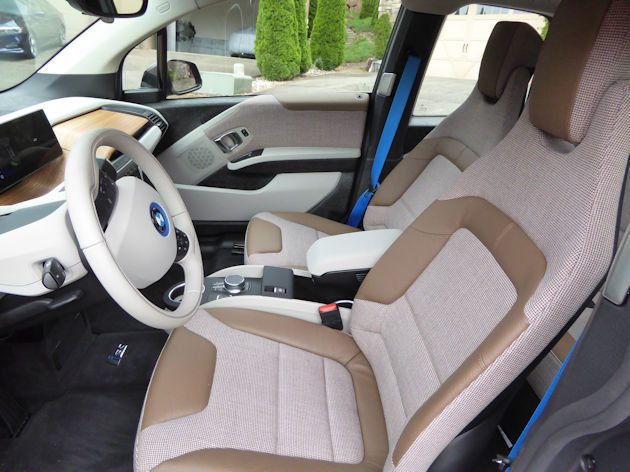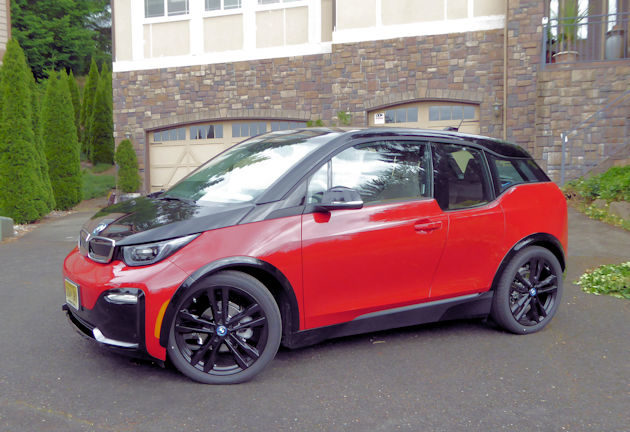By Barbara & Bill Schaffer
Across the lineup BMW gets kudos for building some good-looking cars but one is a visual standout not because of its good looks, but because it?s — weird looking. However, it may be a perfect example of the old saying ?beauty being in the eye of the beholder.?
For someone with a strong environmental interest the BMW i3s is probably seen as a great beauty. And for someone who has the environmental attitude but enjoys the typical BMW driving dynamics, this is the car.

The Ultimate Electric Driving Machine
BMW calls their cars The Ultimate Driving Machine? and the new i3s is one of the best driving hybrids we can think of. Plus, it has impressive credentials in the electric car category. And to add to the Ultimate Driving Machine check list, the new-this-year ?s? model has a larger electric motor, sports suspension and design elements to highlight its all-new dynamic character.

Not Your Typical BMW
From the thoroughly unique styling to the electric motor with range extender to the innovative light-weight construction the BMW i3 is just about as far as you can get from the typical BMW, except in motivation.

A Nice Size
The size of the i3s is 11 inches shorter than a Volkswagen Beetle and it weighs from 300 to 800 less (depending on the way each is configured) even though the BMW has a 450-pound battery.
The interior is deceptively spacious, with about the same size interior as the Volkswagen Beetle. The i3s has two conventional doors each mated with two rear opening doors, like the smaller ones on an extended cab pickup. This pillar-less design allows easier access into the rear seat ? although it is still tight climbing in and out, but it?s better than a coupe where you must climb behind the front seat. The interior is purposely designed for tight city streets. With no transmission tunnel and a low center console a driver can easily scoot across and exit on the passenger side, as an option so he or she doesn?t have to exit on a busy street.

Plenty of Cargo Space
Cargo space is a generous 15.1 cubic feet and the rear seat can be folded down to expand the space to 36.9 cubic feet. There also a little bit of space under the front bonnet, but that space is mostly for the on-board charger cable and tire repair equipment.

Renewable and Recycled Materials
The 2018 BMW i3 interior elements are made extensively from renewable sources and recycled materials some of which look like natural materials rather than the normal slick finished surfaces. For example, the instrument panel surround and door trims have a fibrous texture made from the Kenaf plant. About 25 percent of the plastics in the interior and thermoplastic parts on the exterior are recycled or made from renewable sourced materials. Even the carbon fiber reinforced plastic (CFRP) roof panel is partially made with recycled materials from the manufacturing process of other components. Dashboard wood trim is crafted from responsibly-forested eucalyptus trees.

Carbon Fiber and Aluminum Construction
One of the most advanced features of the BMW i3 is its unique carbon fiber and aluminum construction. The BMW i3 is a purpose-designed vehicle, rather than from an existing internal combustion car converted to battery power. The vehicle is designed in two parts, the passenger cabin, which they call the Life Module, and the Drive Module. The Life Module is constructed of Carbon Fiber Reinforced Plastic, which is as strong as steel and 50 percent lighter ? it?s also 30 percent lighter than aluminum. The aluminum Drive Module holds the 450-pound lithium-ion battery, electric drive train, MacPherson strut front and 5-link rear suspensions, along with structural and crash components. All the weight saving materials keep the car?s weight to about 3,000 pounds or about 3,300 pounds with the Range Extender.

Agile and Balanced
The lighter weight of the Life Module components, along with the low-mounted battery, lowers the i3?s center of gravity and the component placement creates a weight distribution close to 50/50 front/rear. Combined with an ultra-tight 33.8-foot turning radius and the small size it creates a well-balanced and more engaging drive, especially in the city where it easily zips through traffic.

Electric Power
A 170-hp synchronous electric motor with 184-lb.ft. of torque propels the BMW i3. New this year, i3s has a 184-hp motor with 199-lb.ft. of torque. with power from a 32.2-kWh lithium-ion battery. It uses a single-speed transmission to drive the rear wheels. BMW says the i3s will accelerate from 0 to 60 mph is 6.8 seconds or 7.6 seconds when equipped with the range extender. Top speed is limited to 100 mph.

114-Mile Range
On a full charge, BMW says the i3s can go up to 114 miles. The driver can select from a ?Normal,? “Eco Pro”, “Eco Pro+” and a new ?Sport? mode. The two ?Eco? modes change the vehicle?s operations to stretch the charge by 12 and 25 percent respectively according to BMW estimates. They also restrict performance and the vehicle?s cabin cooling and heating abilities. The ?Eco? modes do have a kickdown function that allows drivers to override the Eco modes when a sudden surge of performance is needed.
Ranger and Confidence Extender
For first-time electric car drivers there?s a period of uncertainty centered around the question of ?How far can I go before I run out of battery?? The BMW i3s with the range extender can add great confidence to those drivers.
Our test car was equipped with the optional ($4,450) Range Extender, which is basically a portable battery charger. This is a 38-hp, four-cylinder, 650cc gasoline engine which starts when the battery charge reaches a certain low level. The gasoline engine is used to recharge the battery and starts automatically ? it has nothing to do with physically powering the car. The gasoline engine is fueled by a 2.4-gallon tank and roughly doubles the range of the i3. The Range Extender does add about 330 pounds to the vehicle weight, but it?s the best way we?ve seen to curb the dreaded ?range anxiety? which is so common with electric vehicles.
 Single Pedal Driving?
Single Pedal Driving?
One of the most interesting drive features of the i3 is the Single Pedal Driving Concept. When the driver removes a foot from the accelerator the car automatically brakes, feeding power back into the battery through the vehicle?s regenerative braking system. The braking action is so strong, it?s not necessary to use the brakes except for emergencies ? like when someone pulls out in front of you or when the car is stopped on a slope. The system is a bit disconcerting at first, but after a few minutes behind the wheel, we both loved the convenience of ?automatic braking.?
The Price
The 2018 BMW pricing starts at $45,445 for the i3. The ?s? model is $3,100 more and the range extender adds $3,850. There are three trim levels: Deka World, Mega World and Giga World. Our fully loaded i3s with Range Extender, the Giga World trim and most options had a price of $58,695.
Conclusion
The BMW i3s is a unique car, and if you can live with the looks and afford the price tag it will reward you with practicality, driving enjoyment and efficiency. Plus, you are likely to have the only one on your block.








